Colombia
Corporación de Danza Afrocolombiana Contemporánea Sankofa
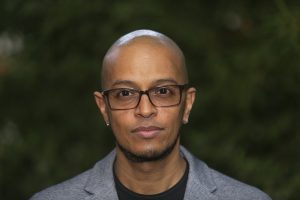 The director of the Sankofa Contemporary Afro-Colombian Dance Corporation is the dancer and choreographer Rafael Palacios, who was born in 1969 in Copacabana, Medellín, Colombia. After undertaking training in African dance at the hands of the teachers Germaine Acoyne and Irene Tassembedo in Paris and influenced by the Mudra School, he undertook a journey through contemporary African and Afro dances that allowed him to visit 18 countries in Central and West Africa such as Burkina Faso, Kenya, Congo, Cameroon, Angola, Eritrea, among others, all influenced by the Mudra School. Upon his return to Colombia, he founded Sankofa, in 1997, which he directs to this day. In 2007, Palacios developed a project called “Steps on Earth; dance, tradition and contemporaneity”, linked to Arts Directorate of the Ministry of Culture, which allowed him to visit several communities in the Colombian Pacific and support training processes around traditional and contemporary Afro dance. In 2008, he obtained the National Dance Award granted by the Ministry of Culture of Colombia and was National Dance Councillor during the period 2009-2011. In that same year, he obtained the Scholarship for the Conservation of Tradition financed by the United States Embassy. He has presented his works in different countries such as Jamaica, Spain, China, the United States, France, Canada, Brazil, Peru, Switzerland, Argentina and Panama. During 2019, together with Sankofa, he had a season of performances in the United States that included the iconic Joyce Theater in New York.
The director of the Sankofa Contemporary Afro-Colombian Dance Corporation is the dancer and choreographer Rafael Palacios, who was born in 1969 in Copacabana, Medellín, Colombia. After undertaking training in African dance at the hands of the teachers Germaine Acoyne and Irene Tassembedo in Paris and influenced by the Mudra School, he undertook a journey through contemporary African and Afro dances that allowed him to visit 18 countries in Central and West Africa such as Burkina Faso, Kenya, Congo, Cameroon, Angola, Eritrea, among others, all influenced by the Mudra School. Upon his return to Colombia, he founded Sankofa, in 1997, which he directs to this day. In 2007, Palacios developed a project called “Steps on Earth; dance, tradition and contemporaneity”, linked to Arts Directorate of the Ministry of Culture, which allowed him to visit several communities in the Colombian Pacific and support training processes around traditional and contemporary Afro dance. In 2008, he obtained the National Dance Award granted by the Ministry of Culture of Colombia and was National Dance Councillor during the period 2009-2011. In that same year, he obtained the Scholarship for the Conservation of Tradition financed by the United States Embassy. He has presented his works in different countries such as Jamaica, Spain, China, the United States, France, Canada, Brazil, Peru, Switzerland, Argentina and Panama. During 2019, together with Sankofa, he had a season of performances in the United States that included the iconic Joyce Theater in New York.
 Sankofa develops a series of educational projects for training in contemporary Afro dance, as well as traditional Afro-Colombian rhythms and urban genres. Its objective is to strengthen self-referential processes among the Afro communities of the city of Medellín, emphasizing the collective memory and the knowledge of Afro-Colombian identities and resistance, as part of the Afro diaspora in the Americas. Rafael Palacios has a degree in Dance Education from the University of Antioquia; a Master’s in Education and Human Rights from the Universidad Autónoma Latinoamericana; he has a diploma in Afro-Latin American Studies from ICESI University and Harvard University; and a diploma in Epistemologies of the South, from the Latin American Council of Social Sciences, CLACSO.
Sankofa develops a series of educational projects for training in contemporary Afro dance, as well as traditional Afro-Colombian rhythms and urban genres. Its objective is to strengthen self-referential processes among the Afro communities of the city of Medellín, emphasizing the collective memory and the knowledge of Afro-Colombian identities and resistance, as part of the Afro diaspora in the Americas. Rafael Palacios has a degree in Dance Education from the University of Antioquia; a Master’s in Education and Human Rights from the Universidad Autónoma Latinoamericana; he has a diploma in Afro-Latin American Studies from ICESI University and Harvard University; and a diploma in Epistemologies of the South, from the Latin American Council of Social Sciences, CLACSO.
The collaborations between Sankofa and the CARLA Project include support in the conceptualization of the work Detrás del Sur: Danzas para Manuel, as well as logistical support for the launch of the work Soledades Compartidas en Tiempos de Pandemia, later relaunched under the name of Narrativas Negras, by the Teatro Metropolitano de Medellín within the framework of DanzaMed, 2020. Recently, at the invitation of Sankofa, the CARLA project has supported workshops to develop the Afro Exhibition: Creative Laboratories in the Home, with an emphasis on Afro-contemporary dance, sponsored by the Mayor’s Office of Medellín within the framework of the Red de Danza programme. Further collaborations include the making of a documentary on creative processes around the work Detrás del Sur.
Sankofa’s work can be described as anti-racist because, through the staging of Afro-contemporary dance, it seeks to dismantle stereotypes about black people that prevent appreciation of the plurality of Afro-descendants and the heterogeneity of their social identities. Likewise, Sankofa affirms the value of resistances that are expressed in the form of community knowledge embodied in traditional and urban dances, which make up collective memories and create bonds of reciprocity. Lastly, Sankofa’s work is related to anti-racism as it questions the legacies of coloniality that affect Afro people, disciplining their bodies, setting standards of Eurocentric beauty, and undermining spiritualities.
For more information about this artist, see https://www.youtube.com/watch?v=78m78cxkE3g&t=1288s>
Margarita Ariza Aguilar
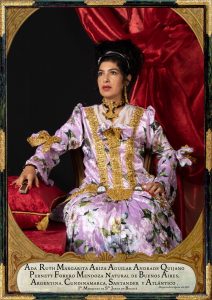 Margarita Ariza Aguilar was born in Buenos Aires, from where she moved to Barranquilla, Colombia when she was very young. Her artistic practice includes performance, video, drawing, painting, public space intervention, making objects and writing, participatory experiences and collaborative actions. In 2011, she started the Blanco Porcelana project that investigates the aspirations of whiteness in the family environment. Based on material she collected about daily beauty practices, verbal expressions, self-care routines, and perceptions of bodies, skin colour, and social status, Ariza revealed the permanence of racism in the shaping of subjectivities hidden in the guise of aspirations to whiteness. The project was censored by the Colombian courts, on charges of violation of family privacy. Then, in 2015, the Constitutional Court ruled in her favour, making it the first case of the protection of the right to free expression in the field of the arts.
Margarita Ariza Aguilar was born in Buenos Aires, from where she moved to Barranquilla, Colombia when she was very young. Her artistic practice includes performance, video, drawing, painting, public space intervention, making objects and writing, participatory experiences and collaborative actions. In 2011, she started the Blanco Porcelana project that investigates the aspirations of whiteness in the family environment. Based on material she collected about daily beauty practices, verbal expressions, self-care routines, and perceptions of bodies, skin colour, and social status, Ariza revealed the permanence of racism in the shaping of subjectivities hidden in the guise of aspirations to whiteness. The project was censored by the Colombian courts, on charges of violation of family privacy. Then, in 2015, the Constitutional Court ruled in her favour, making it the first case of the protection of the right to free expression in the field of the arts.
Ariza is Dean of the Faculty of Visual and Applied Arts in the Departmental Institute of Fine Arts in Cali, Colombia, and teacher in the Plastic Arts programme. She directs the Aisthesis research group of the same faculty. She has been a professor at the Pontificia Universidad Javeriana and at ICESI University. In addition, she has served as a curator at the Museum of Modern Art and an external advisor to the Museum of Modern Art in Barranquilla. Ariza’s artistic practice includes collaborations and interventions in spaces such as museums, public transport and educational spaces. During the Festival of Art and Decoloniality 2019, at the Colonial Museum of Bogotá, the artist made a photographic intervention using the work La Marquesa de San Jorge, by Joaquín Gutiérrez (1775), showing how other mestizo, Afro-descendant and Indigenous bodies could occupy spaces of symbolic power represented by the portrait of the marchioness whose skin was described as “almost made of porcelain.”
The collaborations between Margarita Ariza and the CARLA project have been based on working together in the preparation of academic articles dissemination pieces about Ariza’s work, in particular her work on the figure and portrait of Juan José Nieto Gil, as part of the Black Enough? Project. The work involves the collaboration of 26 visual artists who critically explore the historical invisibilization of the portrait of Colombia’s only Afro president, a promoter of the abolition of slavery in the country during the second half of the republican period. Further collaborations will centre on developing creative processes of performance and reflections around the relationship between racism, whiteness and emotions.
Ariza’s work is related to the themes of the CARLA project in several ways. First, because she approaches racism from the angle of the aspiration for whiteness. She conceives of “white” beyond the colour of the skin, although she does not exclude this element, to show the way in which whiteness is produced and reproduced in everyday practices in private settings such as the family. Second, she is interested in the ways in which whiteness generates effects of invisibilization and un-marking of subalternized identities, forcing them to fit within the ideals of whiteness. In that sense, her work shows how whiteness is a racialized construction of difference. Finally, her work is related to the lines of interest of the CARLA project due to its affective dimension that permits an analysis of the politics of affect through exploring the effects the artworks generate in different audiences.
For more information about this artist, see https://blancoporcelana.wordpress.com/
Ashanti Dinah
Dinah Orozco Herrera, known as Ashanti Dinah, was born in Barranquilla (Colombian Caribbean) and is an Afro-Colombian activist, poet and teacher. Her training has been in languages and literature (she has a Master’s degree in Hispano-American Literature). She is currently a doctoral student at the Harvard University Graduate School of Arts and Sciences (GSAS) in the Department of African and African American Studies and Romance Languages and Literatures.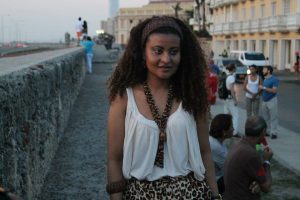
She has published a collection of poems, Las semillas del Muntú (2019) and has another unpublished, Alfabeto de una mujer raíz. Her poems have been translated into Portuguese, English and Bulgarian, and have won several awards, including the Benkos Biohó Prize (Bogotá, 2016).
From the socio-critical perspective of literary, cultural and decolonial studies, her research has focused on investigating and analysing how literary works by Afro-Latin American writers resist the institutional and monological codes of imperial language and contest racism and other forms of oppression by means of a kind of aesthetic marronage.
Ashanti Dinah’s collaboration with CARLA consists of a long contribution to our blog, participating in online events about art, antiracism and affect, and working with CARLA researcher, Carlos Correa, and Afro-Colombian artist, Wilson Borja, to produce an animated version of three of her poems from Las semillas del Muntú for CARLA’s online exhibition. The poems and illustrations touch on Afro spirituality and ancestrality, affirming Afro epistemologies in the context of anti-racist struggles and literature.
Pedro Blas Julio Romero
Pedro Blas Julio Romero was born in Cartagena and where he still lives today, in Getsemaní, a neighbourhood emblematically associated with social struggles, which he describes as “solemn disorder daubed with life”. Along with his literary production, he directs a poetry workshop, presents a programme on a university cultural radio station and is part of an encyclopaedic investigative program on Latin jazz and Afro-Caribbean music. He has published the books Cartas del soldado desconocido (1971), Poemas de Calle Lomba (1988) and Rumbos, the last of which won the Jorge Artel National Poetry Prize in 1993. The collection Obra poética (2009) includes all three books.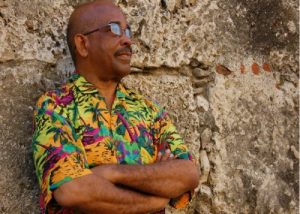
His works consist of a creativity that is critical of the social order, reaffirming individual freedoms and populated with references to ordinary people. Its neo-baroque aesthetics and its African and Amerindian framework reveal memories of resistance in the microcosm that is Getsemaní, by drawing parallels between this neighbourhood of Cartagena and the American continent. The crime of his hero is being black, of Caribbean coastal origin, illegitimate, coming from a poor neighbourhood and, above all, having dreamed of a body. Cielo Patricia Puello Sarabia and Wilfredo Esteban Vega Bedoya, writers of the prologue to Obra poética, present the essence of Pedro Blas’s poetry in this way: “here in this neighbourhood of America are the African voices, the native American voices that preserve a heritage of forms of organization of the world that deny the domination and extinction of the other: the resistance is cultural”.
Pedro Blas’s collaboration with CARLA consists of working with CARLA researcher, Carlos Correa, giving interviews that have contributed to our understanding of anti-racism from the literary perspective, and working with Colombian illustrator Hanna Ramírez, to produce an illustrated version of one of his poems for CARLA’s online exhibition.
CARABANTÚ
 The Afro-Colombian Corporation for Social and Cultural Development – CARABANTÚ – was founded in 2003 with the aim of working for and for the Afro-descendant communities that migrated to the city of Medellín. Since its inception, the organization has developed strategy of using film as an ethno-educational tool, through shows and festivals of Afro-descendant films and photography and video workshops.
The Afro-Colombian Corporation for Social and Cultural Development – CARABANTÚ – was founded in 2003 with the aim of working for and for the Afro-descendant communities that migrated to the city of Medellín. Since its inception, the organization has developed strategy of using film as an ethno-educational tool, through shows and festivals of Afro-descendant films and photography and video workshops.
CARABANTÚ has a particular approach: using film as an ethno-educational tool that challenges stereotypes and seeks other ways of narrating the realities of Afro people from their own perspectives and in their own language. The organization works to implement this through the screening and discussion of films related to the memory of populations of African origin, the African continent and the African diaspora. This work dialogues with the CARLA project because it develops audiovisual and narrative reflections that seek to dismantle the ways in which racism is perpetuated through the construction of stereotyped images and narratives about Afro people. Audiovisual narratives are a place of enunciation from which Afro populations can build their own images and representations of their ways of being and living.
Since 106, CARABANTÚ has organized the International Afro Community Film Festival “Kunta Kinte” (FICCA is the Spanish acronym). FICCA Kunta Kinte’s main objective is to build a process through which the people who live in the neighbourhoods of Medellin can become social protagonists and act as disseminators of a film culture committed to Afro-descendant causes.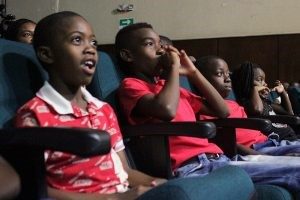
The collaboration of the CARLA project with CARABANTU consisted of supporting the organization of the 6th edition of the FICCA Kunta Kinte. In this edition, boys, girls and young people addressed the issue of Afro leadership in their communities and neighbourhoods. During the collaborative work, CARLA supported and collaborated with the recording of the short films made by the children and young people. We worked together with workshop leaders and directors who offered training and education to children and young people.
Wilson Borja
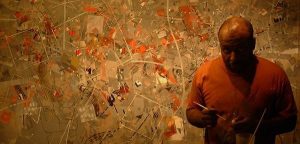 Wilson Borja is an illustrator, graphic designer and teacher based in Bogotá. His work focuses on expanding knowledge about people and cultures of African descent in the diaspora. He is part of a collective, AguaTurbia, that addresses issues and problems related to the construction of race in their community, in the Afro-Colombian social movement, and in the African diaspora in general, through the medium of art. The collective was formed to reflect on their artistic practices, the conditions that confront Afro artists in Bogotá (a city with a majority “white-mestizo” population) and the possibilities of developing their work in that context.
Wilson Borja is an illustrator, graphic designer and teacher based in Bogotá. His work focuses on expanding knowledge about people and cultures of African descent in the diaspora. He is part of a collective, AguaTurbia, that addresses issues and problems related to the construction of race in their community, in the Afro-Colombian social movement, and in the African diaspora in general, through the medium of art. The collective was formed to reflect on their artistic practices, the conditions that confront Afro artists in Bogotá (a city with a majority “white-mestizo” population) and the possibilities of developing their work in that context.
Borja’s work combines and explores innovative techniques of illustration, animation, drawing and photography, among others. Through his work he revitalizes cultural traditions of African origin and brings them up to date by bringing them into the contemporary context. His work explores various types of historical sources on the transatlantic slave trade and resistance strategies among people of the Afro diaspora. It focuses on themes that combine the past, present and future of Afro-descendant populations. He defines his position as an “art-ivism”, insofar as he considers that his commitment to the Afro population guides his artistic creations.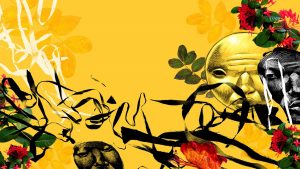
His collaboration with the CARLA project is based on the illustrations of the poems of the writer and poet Ashanti Dinah Orozco, corresponding to her collection of poems, Las semillas del Muntu. Borja gives an interpretation and a reading of the poems by means of animated illustration, where he highlights elements of Afro-Yoruba spirituality. In his illustrations, emphasis is placed on the presence of the ancestors, the communion between the living and the dead, and the integration between the human and natural world.
Las Emperadoras de la Champeta
The Emperadoras de la Champeta, based in the Caribbean coastal city of Cartagena, are the first musical group in the genre of champeta music that consists entirely of women. Led by Mily Iriarte, they promote the participation of “champetúo” artists in a genre dominated by men. Despite the fact that women have always been present in the musical culture of champeta, participating as dancers, performers, composers, samplers, and arrangers, their presence has been largely invisible and little recognised.
Las Emperadoras promote a message of gender equity and critically explore expressions of sexism and racism on the champeta music scene. The women who participate in champeta face prejudices that represent them as women who lead a licentious life, are not “good mothers” and are “easy women”. The members of the group defy these stereotypes, which are doubly rooted in their class and their ethnic-racial origins: they are women of mixed Afro-Colombian and Indigenous descent who live in the working-class neighbourhoods of the city. They dedicate themselves to formal and informal jobs, studying and raising their children, while also developing their artistic careers.
The collaboration between Las Emperadoras de la Champeta and the CARLA project consisted principally of recording new songs, one of which features as a video in the project’s online exhibition. The song is called “Pará en la raya”, which is a popular expression taken from the neighbourhoods of Cartagena that means “standing your ground” in a defiant way. The lyrics highlight the injustices of women’s double burden (of employment and domestic work) and of harassment in the workplace, as well as the domestic violence suffered by many women of the city’s working classes. The video is complemented by an interview with group leader, Mily Iriarte, about the relationship between champeta, anti-racism and gender struggles.
